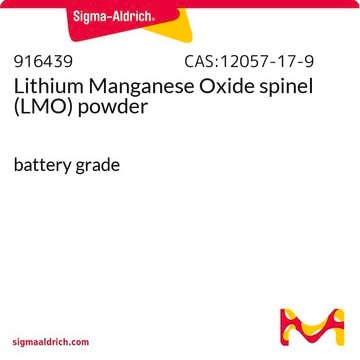934771
Lithium iron phosphate
electrode sheet, aluminum substrate, size 5 in. × 10 in.
Synonim(y):
LFP electrode
About This Item
Polecane produkty
Materiały
aluminum substrate (current collector)
Poziom jakości
klasa czystości
battery grade
opis
Capacity: >= 170 mAh/g
Description/Nominal Voltage: 3.2 V vs. Li/Li+
Próba
≥98% (active material characteristic)
skład
Active material loading 7.3 mg/cm2 ± 5%, ≥85%
charakterystyka ekologicznej alternatywy
Design for Energy Efficiency
Learn more about the Principles of Green Chemistry.
sustainability
Greener Alternative Product
rozmiar
16 μm , aluminum current collector
5 in. × 10 in.
grubość
70 μm ± 5% , excluding current collector
wielkość porów
~2 μm particle size (active material characteristic)
pojemność
≥170 mAh/g (Nominal)
Zastosowanie
battery manufacturing
kategoria ekologicznej alternatywy
Powiązane kategorie
Opis ogólny
Zastosowanie
produkt powiązany
Kod klasy składowania
13 - Non Combustible Solids
Klasa zagrożenia wodnego (WGK)
WGK 3
Temperatura zapłonu (°F)
Not applicable
Temperatura zapłonu (°C)
Not applicable
Certyfikaty analizy (CoA)
Poszukaj Certyfikaty analizy (CoA), wpisując numer partii/serii produktów. Numery serii i partii można znaleźć na etykiecie produktu po słowach „seria” lub „partia”.
Masz już ten produkt?
Dokumenty związane z niedawno zakupionymi produktami zostały zamieszczone w Bibliotece dokumentów.
Nasz zespół naukowców ma doświadczenie we wszystkich obszarach badań, w tym w naukach przyrodniczych, materiałoznawstwie, syntezie chemicznej, chromatografii, analityce i wielu innych dziedzinach.
Skontaktuj się z zespołem ds. pomocy technicznej








